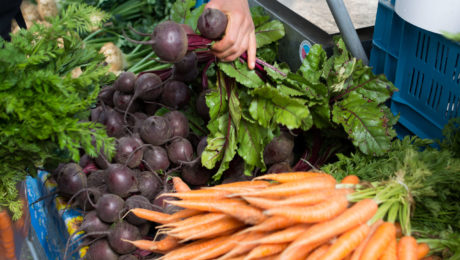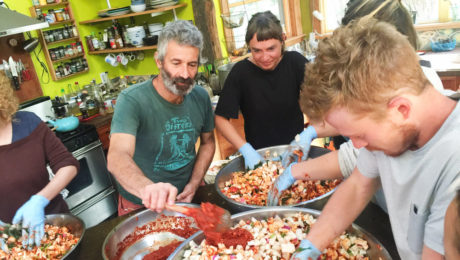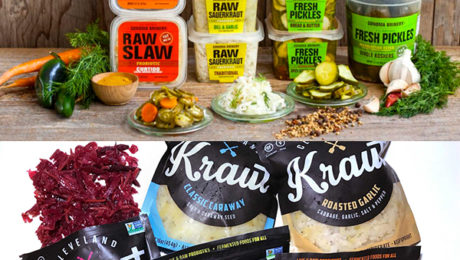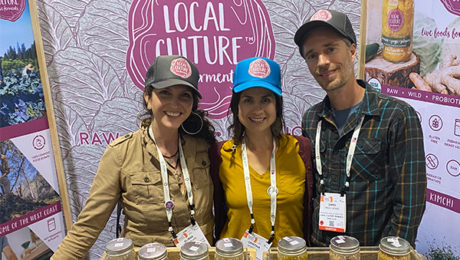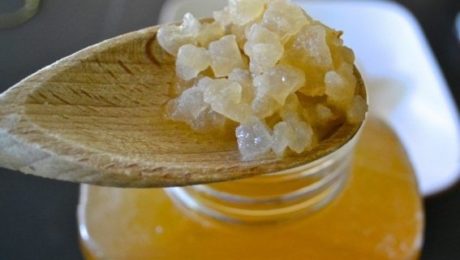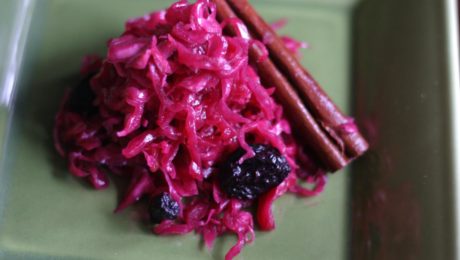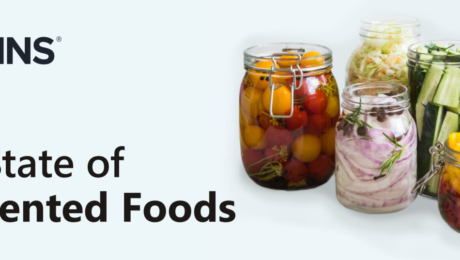PBS Features HEX Ferments
Baltimore-based HEX Ferments was the star of the PBS show START UP. The series highlights small American business owners, chronicling what it takes to start a successful business.
During the episode, HEX Ferments co-founder Maegan Carpenter schooled START UP host Gary Bredow on ferments and gut health. She explained how the modern gut microbiome has been eroded by antibiotics, but fermented foods help to populate and repopulate the digestive system with good bacteria.
“What you’re getting essentially is a vegetable that’s been fermented in a blanket of bacteria that’s indigenious to our bodies: lactobacillus,” Carpenter explained, while Bredow sampled HEX’s seasonal Spirit Berry kombucha and Pizza Kraut sauerkraut.
A former art professor, Carpenter and her co-founder husband Shane, a former wedding photographer, never planned to start a fermentation business. Carpenter began teaching people how to use produce from their local community garden, offering tastings of the vegetables she fermented. Orders for her ferments started showing up in her mailbox. Carpenter said she thinks the demand came from “being open with people and showing people something that has been taken out of our culture for so long.”
Bredow added about modern food convenience: “It’s scary to think about if that convenience goes away, are we going to have a society of people incapable of watching food rot right in front of them.” Carpenter responded: “I think we already do.”
HEX Ferments will be expanding into a new, larger retail space later this year, HEX Superette. The space includes a kombucha taproom, small restaurant area to serve small plates, space to teach education classes and a local food marketplace. HEX Superette, Carpenter said, will “answer the question, ‘How do I eat this?’ because after 10 years of making fermented foods, we often get that question.”
Bredow concluding the episode noting that fermentation was born out of food scarcity, something today’s generation did not understand until the Covid-19 pandemic.
“Our ancestors planned for the future knowing that self sufficiency can mean the difference between life and death. Maybe it’s time to revisit the skills that allowed past generations to live with less fear and reliance on a system that always seems to be on the brink of collapse,” Bredow said. “I love what Meghan and Shane are doing. They’re not only offering up tasty and healthy foods, they’re reminding us how important it is to learn this lost craft before it’s too late…they’re offering fermentation classes. To me, this really is purpose. A focus on doing well and doing good for the world around them.”
- Published in Business, Food & Flavor
Does Organic vs. Conventional Matter for Fermented Foods?
Organic food is considered by some to be healthier and more nutritious than its conventional counterpart. But what about when that food is fermented? Does organic vs. conventional matter?
A new study reveals some surprising results: when it comes to fermented foods, “the quality of organic food is not always better than conventional food.”
Organic vs. conventional agricultural production is a hotly debated topic – some reports indicate organic food is more nutritious, but other research suggests the nutritional differences are not significant. Meanwhile, fermented foods are scientifically-proven to include higher nutritional value. “During fermentation, the concentration of many bioactive compounds increases, and the bioavailability of iron, vitamin C, beta carotene, or betaine is also improved,” the study notes. Fermented products also “inhibit the development of pathogens in the digestive tract.”
Researchers at the Bydgoszcz University of Science and Technology in Poland questioned whether fermenting organic food would change its nutritional output versus using conventional food. Their results were published in the journal Molecules.
Analyzing fermented plants (pickles, sauerkraut, beet and carrot juices) and dairy (yogurt, kefir and buttermilk), researchers measured the vitamins, minerals and lactic acid bacteria in the items. They compared using organic ingredients in one group to products made from conventional ingredients.
“Research results do not clearly indicate which production system–conventional or organic–provides higher levels of bioactive substances in fermented food,” the study reads.
Results were mixed. Lactic acid bacteria – the good, healthy kind – were higher in organic sauerkraut, carrot juice, yogurt and kefir. Organic kraut and pickles produced more vitamin C than conventional versions. And calcium levels were higher in yogurt made with organic milk.
But, interestingly, lactic acid bacteria levels were higher in conventional pickles and beet juice. Conventional beet juice also had five times more beta-carotene (vitamin A).
Read more (Molecules)
A Nutrition Pro’s Fermentation Guide
Nutrition professionals need to share the details when recommending fermented products to clients. What are the health benefits of the specific food or beverage ? Does the product contain probiotics? Live microbes?
“There are a vast array of fermented foods. This is important because it means there can be tasty, culturally appropriate options for everyone,” says Hannah Holscher, PhD and registered dietitian (RD). But, she adds, remember that these are complex products.
Holscher spoke at a webinar produced by the International Scientific Association for Probiotics and Prebiotics (ISAPP) and Today’s Dietitian. Joined by Jennifer Burton, RD and licensed dietitian/nutritionist (LDN), the two addressed the topic Fermented Foods and Health — Does Today’s Science Support Yesterday’s Tradition? Hosted by Mary Ellen Sanders, executive director of ISAPP, the presentation touched on the foundational elements of fermented foods, their differences from probiotics, the role of microbes in fermentation, current scientific evidence supporting health claims and how to help clients incorporate fermented foods in their diets.
Sanders called fermented foods “one of today’s hottest food categories.” Today’s Dietitian surveys show they are a top interest to dietitians, as the general public often turns to them with questions about fermented foods and digestive health.
Here are three factors highlighted in the webinar that dietitians should consider before recommending fermented foods and beverages.
Does It Contain Live Microbes?
Fermentation is a metabolic process – microorganisms convert food components into other substances.
In the past decade, scientists have applied genomic sequencing to the microbial communities in fermented foods. They’ve found there’s not just one microbe involved in fermentation, Holscher explained, there may be many. The most common microbes in fermented foods are streptococcus, lactobacillaceae, lactococcus and saccharomyces.
But deciphering which fermented food or beverages contains live microbes can be difficult.
Live microorganisms are present in foods like yogurt, miso, fermented vegetables and many kombuchas. But they are absent in foods that were fermented then heat-treated through baking and pasteurization (like bread, soy sauce, most vinegars and some kombucha). They’re also absent in fermented products that are filtered (most wine and beers) or roasted (coffee and cacao). And there are foods that are mistakenly considered fermented but are not, like chemically-leavened bread, vegetables pickled in vinegar and non-fermented cured meats and fish.
“The main take-home message is that it’s not always easy to tell if a food is a fermented food or not. So you may need to do more digging, either by reading the label more carefully or potentially contacting the food manufacturer,” Holscher said. “When we just think of if live microbes are present or not, a good rule of thumb is if that food is on the shelf at your grocery store, it’s very likely that it does not contain live microbes.”
Does It Contain Probiotics?
The dietitians stressed: probiotics are not the same as fermented foods.
“Probiotics are researched as to the strains and the dosages to be able to connect consumption of a probiotic to a health outcome,” Holscher said. “These strains are taxonomically defined, they’ve been sequenced, we know what these microorganisms can do. They also have to be provided in doses of adequate amounts of the live microbes so foods and supplements are sources of probiotics.”
Though fermented foods can be a source of probiotics, Holscher notes: “In most fermented foods, we don’t know the strain level designation.”
“For most of the microbes in fermented foods, we’ve just really been doing the genomic sequencing of those over the last 10 years and so we may only know them to the genus level right,” she said. For example, we know lactic acid bacteria are present in kimchi and sauerkraut.
Holscher suggests, if a client has a specific health need, a probiotic strain should be recommended based on its evidence-based benefits. For example, the probiotic strain saccharomyces boulardii is known to help prevent travel-related diarrhea, and so would be good for a patient to take before a trip.
“If you’re looking to support health and just in general, fermented foods are a great way to go,” Holscher says.
The speakers recommended looking for probiotic foods in the Functional Food Section of the U.S. Probiotic Guide.
Does Research Support Health Claims?
Fermentation contributes to the functional and nutritional characteristics of foods and beverages. Fermented foods can: inhibit pathogens and food spoilage microbes, improve digestibility, increase vitamins and bioactives in food, remove or reduce toxic substances or anti-nutrients in food and have health benefits.
But research into fermented foods has been minimal, mostly limited to fermented dairy. Dietitians should be careful making strong recommendations based on health claims unless those claims are supported by research. And food labels should always be scrutinized.
“There’s a lot of voices out there that are trying to answer this question [Are fermented foods good for us?],” says Burton. “Many food manufacturers have published health claims on their labels talking about these benefits and, while those claims are regulated, they’re not always enforced. Just because it has a food health claim on it, that claim may not be evidence-based. There’s a lot of anecdotal accounts of benefits coming from eating fermented foods and the research is suggesting some exciting potential mechanisms. But overall we know as dietitians we have an ethical responsibility to practice on the basis of sound evidence and to not make strong recommendations if those are not yet supported by research.”
Reputable health claims are documented in randomized control trials. But only “possible benefits” can be linked to nonrandomized controlled trials. And non-controlled trials are the least conclusive studies of all.
For example, Burton puts miso in the “possible benefits” category because, with its high sodium content, there’s not enough research indicating it’s safe for patients with heart disease. Similarly, she does not recommend kombucha because of its extremely limited clinical research and evidence.
“We have to use caution in making these recommendations,” Burton says.
This is why Burton advises dietitians to be as specific as possible. Don’t just tell patients “eat fermented foods” — list the type of fermented food and its brand name. She also says to give patients the “why” — what is the benefit of this fermented food? Does it increase fiber or boost bioavailability of nutrients?
“Are fermented foods good for us? It’s safe to say yes,” Burton says. “There’s a lot that we don’t know, but the body of evidence suggests that fermentation can improve the beneficial properties of a food.”
Sandor Katz: “Don’t be Intimidated by Fermentation”
Further catapulting fermentation into the culinary zeitgeist: Sandor Katz was a guest on the Rachael Ray Show, talking about fermentation and sharing a homemade sauerkraut recipe.
“Everybody eats and drinks products of fermentation everyday,” Katz said on the show’s March 8 episode. “Fermentation, which is the transformation action of microorganisms, is so integral to how we make effective use of whatever food resources are available to us.”
Katz, author of six books on fermentation, stressed “bread is fermented, cheese is fermented, cured meats are fermented, condiments are either directly fermented or they rely on vinegar, which is a direct product of fermentation.”
Katz demonstrated how to make a sauerkraut for viewers, encouraging them: “Don’t be intimidated by fermentation.”
Read more (Rachael Ray Show)
- Published in Food & Flavor
Cleveland Kitchen Acquires Sonoma Brinery
One of the under-the-radar stories from the recent Expo West was another acquisition in the fermented foods space, coming on the heels of the Bubbies and Wildbrine purchases. Ohio’s Cleveland Kitchen, producers of sauerkraut, kimchi, salad dressings and pickles, bought Healdsburg,Calif.-based Sonoma Brinery (makers with a similar line-up of pickles, kraut and pickled vegetables). No public announcement has been made, but executives from both companies confirmed the transaction to TFA. Sonoma Brinery founder/owner David Ehreth is expected to remain with the company. [Note – both Ehreth and Cleveland Kitchen’s Drew Anderson have been TFA Advisory Board members since the organization’s inception.]
- Published in Business
Q&A with Local Culture
In a food industry where greenwashing is common, Local Culture Live Ferments doesn’t pad their sales sheets with faux environmental fluff. Sustainability is core to their business practices.
“I never want to stray away from the connections with our farmers. I never want to stray away from the quality of our ferments,” says Chris Frost-McKee, director of operations for the Northern California-based vegetable fermenter. Sauerkraut is their top seller. “We take a lot of pride from the fact that we don’t ferment in plastic. We are doing our part to be as plastic-free as possible and leave the smallest footprint that we can.”
The company began as a passion project of Chris’ sister, Sarah. She recruited her brother, a home fermenter since his early 20s, and they envisioned creating two Local Culture fermentation hubs on the west coast — one where Sarah lives, in Bend, Ore., and a second in Grass Valley, Calif., Chris’ home. True to their name, they wanted to ferment with local produce. But, with the colder climate in Central Oregon cutting Bend’s growing season short, this proved impossible.
“In Grass Valley, we’re able to source cabbage eight miles from our facility, eight months out of the year. We’ve created partnerships where every year the farm is planting more and more acreage for us, rotating their cover crops. It’s a beautiful thing, it’s real regenerative farming,” Chris says. And Sarah is now creating a separate project, fermented salad dressings, under the Super Belly Ferments brand.
Local Culture started as a farmers market side hustle, but Chris and his business partners (wife Cristina and friend Elissa Wolf Blank, pictured with Chris) dove into scaling the business in 2020. They’re now in over 100 grocers in the west, including Whole Foods. Though sales boomed during the pandemic, 2022 is shaping to be their biggest year. At the recent Expo West, Local Culture was one of 40 brands selected by food distributor KeHe for the exclusive “Golden Ticket” at their TrendFinder Event This designation fast-tracks small businesses into KeHe’s product portfolio, giving them exposure to over 30,000 retail locations.
Below is a Q&A with Chris Frost-McKee, who spoke with The Fermentation Association on the Expo West show floor.
TFA: Congrats on the KeHe “Golden Ticket” win! What are you going to have to change about scaling?
Chris Frost-McKee: The tricky thing with scaling the way that we do, our fermenters are stainless steel, variable capacity fermenters. We currently have 66 of them. We’ll need to get more as we scale, but they’re only sold once a year during wine making season. They ship them over from Italy. So that presents difficulties for sure. Producing in the same size fermenters, that’s part of the integrity we’re going to keep, that’s very important to me. We ferment for a minimum of 4-6 weeks in a very regulated, temperature-controlled environment. That really helps with the consistency of our product.
We are also keeping the values the same with our farmers, making sure they can scale while staying sustainable. We’re scaling up our acreage with our main farmer next year. They rotate three successions of a summer variety of cabbage for us and then one succession of winter storage. And with those four successions, we can work about eight months directly with them, never going into cold storage.
You just returned from a planning meeting with the local farm that supplies your cabbage. Tell me more about the farmers you work with.
CFM: We’re trying to only work farmer direct. One of our closest connections is the farm Super Tuber. They are Nevada City-based. They focus on regenerative farming practices and they focus on staple root crops and cabbage. So from the very beginning, as we first started with these smaller products, we started buying cabbage from them. Twice a year we sit down with them with the planting planning: What do you think it’s going to look like this year? How many plugs on your side can you plant for us?
Super Tuber is really into this idea and I love it — they harvest in reusable bins in the field, then bring them straight to us in reusable bins. When you work with farms, produce comes in paraffin or wax boxes. Those go straight in the landfill. We are trying to have as little waste as possible. We’d love to never receive anything in wax boxes, and we’re there about 95% of the time. We compost everything that comes out of the kitchen.
Another thing, the cabbage isn’t wrapped in plastic packaging. We peel off the outer cabbage leaves as we prep in the kitchen. Those outer leaves are what I like to layer on top to seal everything. It weighs the ferment batch down and provides a nice layer if there’s ever an impurity — which really doesn’t happen — so if we ever discard anything, it’s those top leaves that would normally get composted.
What was the biggest turning point for your brand to go from selling at farmer markets to getting in stores?
CFM: Honestly, as corporate as Whole Foods is, they have a wonderful way of supporting small brands. The west coast is filled with small ferment companies trying so hard and not succeeding at getting in. Whole Foods saw potential in us. That was really the turning point for our company. And they’ve continued to be loyal to us. Not all chains are pleasant to work with, but we made big moves through Whole Foods. It opened up this door to the Bay Area independents, like the Good Food Mercantile and the Good Food Awards. The Bay Area independents are so cutting edge in a way that I think a lot of these big chains strive to be as far as the products that they bring in and the diversity they really search for in craft products. At this point, we’re almost everywhere in the greater Bay Area that we’ve set out to be in — and I do think that started with getting in Whole Foods in 2020.
TFA: How were you distributing before that?
CFM: We were driving all over Northern California. We would drive five hours round trip to drop off like 10 cases of kraut. It did not make sense long term. Now we work with Tony’s Fine Foods to distribute to the pacific region. Tony’s has been supportive from the beginning.
We still self distribute locally, but only whatever we can do in a 20 minutes drive. The local support that we have, that started with our stands at the farmers market and then our storefront, that support has been amazing. Like we honestly sell more in our local co-op then we do in 40 stores in the Pacific Northwest. That kind of local support will always be there.
TFA: That’s great that you have a big local fan base.
CFM: When we decided to get going in Grass Valley, we opened up a store front for a year-and-a-half and had this really great interface with our community. We were really experimental in those years. That was the year I was coming up with a lot of small batches. When we were invited to be in the Whole Foods, we had to move to a distributor and palletize. Things were not so small batch anymore. Right as the pandemic hit, we started being received really well in the west coast. We streamlined the products that people really wanted. We’ve got our favorite line of krauts, our different kimchis. We still do a lot of hot sauces and brine tonics.
TFA: What is your favorite flavor?
CFM: Turmeric Ginger Jalapeno is my go-to, everyday. My body craves it. Our Beet Fennel though outsells anything we carry. People love it.
TFA: You’ve gone from fermenting in your home kitchen to distributing regionally. What do you think has been your biggest lesson in all of this?
CFM: Not giving up. Listening to the ferments — it sounds really weird, but I literally have studied patterns in the life within the fermenters. For example, we have these variable capacity lids that have an airlock on the top where the brine can spit out. In certain ebbs and flows, I think it’s astrological, all the fermenters will come to life, no matter how old they are. Or in a certain cycle of the moon, all of them will compact and leave an air pocket that I have to reset. It is crazy, witnessing the nature and patterns.
Through all the trial and error and discouragement, it’s the life of the microbiology itself that is really the inspiring thing. I could never get it right, it’s always going to be different no matter what. But I’m getting a lot better at creating that perfect environment for consistency. If you ask me — I’m living and breathing it because I digest this all the time.
TFA: Where do you see the future of fermentation?
CFM: I see it growing. It is beyond all the trends, it’s something that’s been around for ages, for centuries, and there’s a reason why it’s always been incorporated in our diets. There’s this sense of awakening that so many people in the mainstream are feeling — if it’s kombucha, if it’s sauerkraut, if it’s kefir, if it’s yogurt — people are really feeling the benefits. The pandemic has had a huge influence on that, too. I think everyone in grocery would agree fermentation is a big thing right now and it deserves to be a big thing.
- Published in Business, Food & Flavor
Study: What Bacteria Survive Digestion?
New research has explored how lactic acid bacteria (LAB) in sauerkraut and tibicos survive digestion and change gut microbiota composition.
This work, published in Frontiers in Microbiology, investigated how a fermentation production process affects LAB and yeast microbial viability and probiotic potential. Though there are studies that demonstrate health benefits of fermented foods, few “explore how being part of a whole fermented food matrix affects microbial viability during fermentation, storage and gastrointestinal (GI) transit.”
The study focused on non-dairy, botanical fermented foods, defined as “microbially transformed plant products rich in health-promoting components.” Tibicos and sauerkraut were chosen because recent research had found the microbial diversity of the two ferments “far exceeded that of dairy-based ferments, as well as containing the largest numbers of potential health-promoting gene clusters.” The tibicos studied was sugar-based while the sauerkraut was brine-based, and both contained various strains of LAB and bioactive components.
Ginger, cayenne pepper and turmeric added to tibicos were all found to have different survival rates in the digestion tract. These functional spices are often added to fermented products for their anti-inflammatory and sensory properties, but their microbial proliferation had never been adequately explored. Cayenne was the clear winner, as adding it to tibicos “significantly improved the survival rate of LAB during simulated gastric and small intestinal digestion compared to ginger and turmeric.” Ginger in tibicos had a higher rate of LAB survival than turmeric, though neither had a significantly higher LAB survival rate than plain tibicos. But adding ginger significantly increased and sustained microbial viability of LAB.
The research team — from University of Melbourne — did not perform the study on human subjects, but simulated upper gastrointestinal digestion and colonic fermentation tests using pig feces.
Some other significant findings:
- For an optimal microbial survival rate of 70-80%, tibicos should be consumed within 28 days, and sauerkraut within 7 weeks.
- Sauerkraut made with different salt concentrations did not show any significant variation in LAB counts.
- Inoculating sauerkraut with a starter culture increased LAB counts during fermentation and storage. But, by the end of storage, the LAB counts in the inoculated sauerkraut “dropped to undetectable levels.”
- Spontaneously-fermented sauerkraut LAB counts remained stable through the storage period.
“Botanical fermented foods are cheap, easily made, and consumed globally,” the study concluded. “This makes them excellent candidates for the dietary management of pro-inflammatory noncommunicable diseases, such as type 2 diabetes and metabolic syndrome.
“Bacterial Bully” Could Create Healthier & Tastier Fermented Foods
Microbiologists have long considered that there are two distinct categories of energy conservation in microorganisms: fermentation and respiration. Lactic acid bacteria (LAB) use fermentation, making it central to food and drink production and preservation since the dawn of man.
But researchers at the University of California, Davis, and Rice University discovered a LAB species that uses a hybrid metabolism, combining both fermentation and respiration.
“These are two very different things, to the extent that we classify bacteria as basically one or the other,” said Caroline Ajo-Franklin, a bioscientist at Rice University and co-author of the study. “There are examples of bacteria that can do both, but that’s like saying I can ride a bicycle or I can drive a car. You never do both at the same time.”
“What we discovered is a LAB that blends the two, like an organism that’s not warm- or cold-blooded but has features of both,” she said. “That’s the big surprise, because we didn’t know it was possible for an organism to blend these two distinct metabolisms.”
The species — lactiplantibacillus plantarum — is what scientists call a bacterial bully because it takes advantage of two distinct metabolic processes, according to a press release from Rice on the study. These systems were “not previously known to coexist to acquire the fuel they burn for energy.”
“Using this blended metabolism, lactic acid bacteria like L. plantarum grow better and do a faster job acidifying its environment,” said Maria Marco, a professor in the food science and technology department at UC Davis and the study’s co-author [and a TFA Science Advisor].
The discovery is significant for food and chemical production. New technologies that use LAB could now produce healthier and tastier ferments, minimize food waste and change the flavors and textures of fermented food.
“We may also find that this blended metabolism has benefits in other habitats, such as the digestive tract,” Marco said. “The ability to manipulate it could improve gut health.”
The study began with a puzzle: the realization that genes responsible for the electron transfer pathway in mainly respiratory organisms also appear in the LAB genome. “It was like finding the metabolic genes for a snake in a whale,” Ajo-Franklin said. “It didn’t make a lot of sense, and we thought, ‘We’ve got to figure this out.’”
While the Davis lab studied the genome, the team at Rice carried out fermentation experiments on kale.
“It wasn’t our first choice,” said Rice alumna and co-lead author Sara Tejedor-Sanz (now a senior scientific engineer in the Advanced Biofuels and Bioproducts Process Development Unit at Lawrence Berkeley National Lab).
“We performed some initial experiments with cabbage, since that’s a known fermented food — sauerkraut and kimchi — in which lactic acid bacteria are present,” she said. “But there were technical difficulties and it didn’t turn out so well. So we looked for another food to ferment where LAB could be found in its ecological niches.
“Kale has compounds like vitamins and quinones that lactic acid bacteria use as cofactors in their metabolism, and are also involved in interacting with the electrodes,” she said. “We also found fermenting kale to make juice was a trend. It sounded perfect for our biochemical reactors.”
The study showed LAB enhances metabolism through a FLavin-based Extracellular Electron Transfer (FLEET) pathway that expresses two genes (ndh-2 and pp1A) associated with iron reduction, a step in the process of stripping and incorporating electrons into ATP (adenosine triphosphate (ATP), energy-carrying molecule).
Because LAB’s genome has evolved to be small, thus requiring less energy to maintain, the wide conservation of FLEET must serve a purpose, Ajo-Franklin said.
“Our hypothesis is this helps bacteria get established in new environments,” she said. “It’s a way to kick-start their metabolisms and outcompete their neighbors by changing the environment to be more acidic. It’s being a bully.”
That the FLEET pathway can be triggered with electrodes offers many possibilities, she said. “We found we can use the hybrid metabolism in food fermentation,” Ajo-Franklin said. “Now we have a way to change how food may taste and avoid failed food fermentations by using electronics.”
“We may also find that this blended metabolism has benefits in other habitats, such as the digestive tract,” Marco said. “The ability to manipulate it could improve gut health.”
Ajo-Franklin noted LAB are commonly found in the microbiomes of many organisms, including humans. “You can already buy it in health food stores as a probiotic,” she said. “The human gut is an anaerobic environment, so LAB have to keep a redox balance. If it oxidizes carbon to gain energy, it has to figure out a way to reduce carbon somewhere else.
“Now we think if we provide another electron donor or acceptor, we could promote the growth of positive bacteria over negative bacteria.”
UC Davis graduate student Eric Stevens is co-lead author of the study. Co-authors are Rice graduate student Siliang Li; at UC Davis, graduate students Peter Finnegan and James Nelson, and Andre Knoesen, a professor of electrical and computer engineering, at UC Davis; and Samuel Light, the Neubauer Family Assistant Professor of Microbiology at the University of Chicago.
Ajo-Franklin is a professor of biosciences and a CPRIT Scholar. Marco is a professor of food science and technology.
The National Science Foundation, Office of Naval Research, the Department of Energy Office of Basic Energy Sciences and a Rodgers University fellowship supported the research.
The study results were published in the journal eLife.
- Published in Food & Flavor, Health, Science
Covid & the 4k’s: 4 Foods “Many People Don’t Know About”
Renowned professor, epidemiologist and author of The Diet Myth and Spoon Fed Tim Spector is encouraging people to eat the 4k’s: kefir, kombucha, kimchi and kraut. His studies found diet plays a role in preventing severe symptoms of Covid.
Spector is a leading expert on long Covid, the symptoms that can continue for extended periods after an initial infection. He leads the ZOE Covid Study, created by scientists and doctors at King’s College London (where he is based), Stanford, Harvard, Massachusetts General Hospital and health science company ZOE. Last year Spector helped research the attributes and predictors of long Covid, the results of which were published in the journal Nature Medicine.
A microbiome researcher, Spector advocates for people to eat a diverse diet to improve the trillions of microbes in the gut.
“We know from Covid now that your gut health is crucial for your immune system,” he told ITV. “If we can focus on our gut health…gut microbiome is really crucial.”
Diet must be high-quality to improve immunity, he stresses. In the ZOE Covid study, researchers have found eating “the right things and avoiding feeding (the gut) the bad things, that’s what made the difference to getting long Covid,” he said. Fermented foods have proven health benefits, but Spector says many people opt for cheaply-made yogurts and cheeses prevalent in the grocery store to get their daily dose of fermented foods. This dairy is full of sugar and artificial ingredients, which thwart the positive effects of fermentation.
“The other fermented foods that many people don’t know about are what I call the 4 k’s,” Spector says: kefir, kombucha, kimchi and kraut (sauerkraut). He encourages “small shots a day” of a fermented food or beverage. “That really is a powerful enhancer of your microbes. And all these things are going to be cheaper actually than taking multivitamins every day of your life.”
Spector is not a fan of supplements, like pill forms of vitamins and nutrients. Many are proven not to work, he explained. In his studies on the effects of supplements on long Covid, there were minimal benefits for women and none for men.
“People are much better off getting all their vitamins and nutrients by having a diverse diet,” Spector said.
- Published in Food & Flavor, Science
Retail Sales Trends for Fermented Products
Miso, frozen yogurt and pickled and fermented vegetables are driving growth in the $10.97 billion fermented food and beverage category. The fermented products space grew 3.3% in 2021, outpacing the 2.1% growth achieved by natural products overall.
“It really highlights how functional products have become the norm for shoppers when they’re in stores,” says Brittany Moore, Data Product Manager for Product Intelligence at SPINS LLC, a data provider for natural, organic and specialty products. Moore notes there’s an “explosion of functional products” in the market — “[they] are appearing everywhere. And fermented products have been leading that space in the natural market for years.”
The data was shared during TFA’s conference, FERMENTATION 2021. SPINS worked with TFA to drill into data covering 10 fermented product categories and 64 product types (an increase from last year). [A note that wine, beer and cheese sales are excluded from the data. These categories are very large, and would obscure trends in smaller segments. Wine, beer and cheese are also well-represented by other organizations.]
Yogurt dominates the fermented food and beverage landscape with 75% of the market, but sales growth is soft. Frozen yogurt and plant-based offerings, though small portions of the yogurt category, are fueling what growth there is. “Novelty products are catching shopper’s eyes,” Moore notes.
Kombucha, the fermented tea which led the U.S. retail revival of fermented products, still rules the non-alcoholic fermented beverages market, with 86% of sales. But growth is slowing. Moore points out that this slowdown is due to kombucha having penetrated the mass market with lots of brands on grocery shelves.
“There’s opportunity in kombucha for new innovations to catch the progressive shopper’s eye,” Moore says. “Shoppers are looking for an innovative twist to their functional product.”
Moore points to successful twists like hard kombucha, which grew nearly 60%, and probiotic sodas, which grew 31%.
Growth is slowing for hard cider, too, though hard cider leads the alcoholic beverages category with 83% share of sales.
All sectors of the pickled and fermented vegetables category are growing, totalling nearly $563 million in sales. Refrigerated products are nine of the top 10 subcategories here. The “other” pickled vegetable subcategory is increasing at a 60% growth rate, “other” being the catch-all for vegetables that are not cucumbers, cabbage, carrots, tomatoes, beets or ginger. Fermented radish, garlic and seaweed fall into this subcategory.
Soy sauce is not surprisingly still the largest product in sauces, representing 58% of the category. But that share is dropping. Gochujang is the growth leader, increasing at rate of nearly 20%.
Miso and tempeh are also performing well, which Moore attributes to the growing plant-based movement and the Covid-19 pandemic pantry stocking boom. Miso products — soups, broths, pastes and mixes — totaled over $24 million in sales in 2021. Though instant soups and meal cups represented only 8% of sales, they grew more than 110%.
- Published in Business


